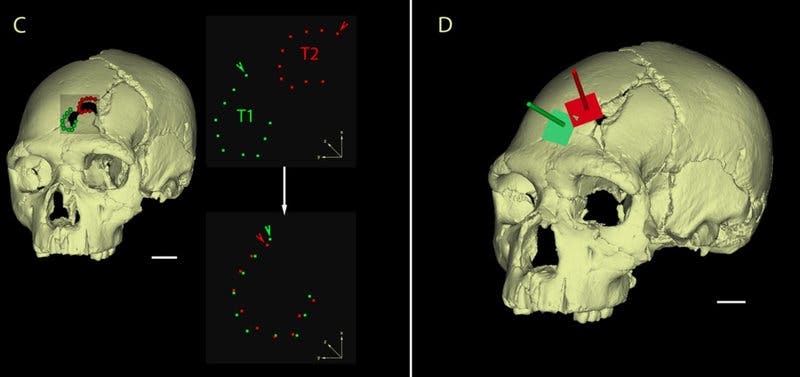Anthropologists have uncovered a 430,000 year old homo skull with fatal wounds that represents the earliest identified murder case in human history.

Researchers used a 3D model to analyze the skull’s two fractures in detail. Photo: Sala et al., PLOS ONE
The almost complete skull called Cranium 17, was discovered broken into 52 pieces and buried under a layer of clay in a cave shaft.
Scientists used modern forensic techniques and discovered that the victim was probably killed by two blows to the head, and then was tossed up against a cave shaft. They employed the help of 3D imaging to analyze the fractures up close and visualize the trajectory of each wound; they found that both wounds were likely caused by the same object.
“Furthermore,” the team adds, “the fractures show different orientations and different trajectories, implying that each fracture was caused by an independent impact.”
In other words, the victim was smacked on the head two times with the same object. It wasn’t an accident – it was an intentional murder.
“In the case of Cr-17 it is also possible to rule out the injuries as either self-inflicted or resulting from an unintentional hunting accident, mainly because the lesions involve multiple blows,” they add. “Based on the absence of cut marks, other potential postmortem manipulations (e.g., cannibalism, ritual manipulations, etc.) seem even less likely and more speculative.”
Furthermore, there seems to be a clear intention to kill.
“Given that either of the two traumatic events was likely lethal, the presence of multiple blows implies an intention to kill.”
The researchers, led by Dr Nohemi Sala, from the UCM-ISCIII Centre for the Evolution and Human Behaviour in Madrid, added:
“This represents the earliest clear case of deliberate, lethal interpersonal aggression in the hominin fossil record, demonstrating that this is an ancient human behaviour.”
The bones were found in a cave called Sima de los Huesos – the “pit of bones” – in northern Spain. The Sima de los Huesos is a well known anthropological point, with numerous findings being reported there. In 2013, researchers found the oldest human DNA ever reported at the same cave.
It’s unclear whether the murderer threw the body in the shaft to get rid of the evidence, or whether the victim was buried there with a religious ceremony. Researchers are now searching for other bodies in other shafts of the cave to see if this was a common practice.










